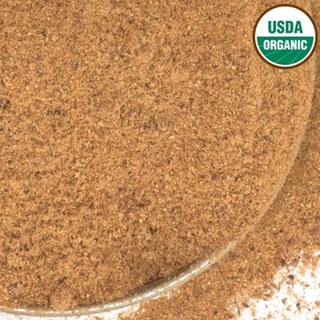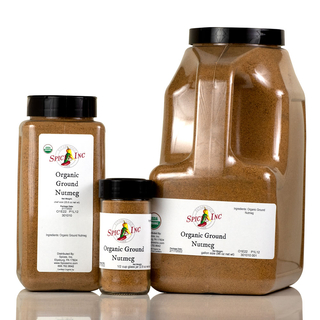Organic Ground Nutmeg




Organic Ground Nutmeg
Organic Ground Nutmeg, Myristica fragrans, is an organically grown and processed, fine brown powder produced from the whole nutmeg. It is also called organic nutmeg, organic nutmeg powder, or nutmeg organic. It has an essential oil content of 6.5% to 16%.
Nutmeg is the seed of a fruit of a fruiting evergreen tree. A fibrous red casing grows around the seed, which can be easily separated and dried. That red casing is also used as a spice,
Organic Ground Nutmeg is popular with:
- butchers;
- coffee shops;
- seasoning companies;
- independent spice shops; and
- bakeries
2-3 teaspoons of ground nutmeg are approximately equal to one whole nutmeg.
We also have conventional Ground Nutmeg and conventional Whole Nutmeg available.
Flavor Profile
Organic Ground Nutmeg can taste piney, spicy, sweet, and slightly bitter or nutty with hints of clove.
How To Use
Use Organic Ground Nutmeg as a garnish for eggnog, as it pairs well with cinnamon and clove. Add it to Chai Spiced Overnight Oats for a hearty breakfast, or to Pineapple Zucchini Quick Bread. Organic Ground Nutmeg also works well in savory dishes like Spanish Shrimp Tapas or as a playful element in Sweet Twist Potato Skins. It is a secret weapon in sauteed greens like spinach and kale.
Organic Ground Nutmeg is usually added at the end of recipes. Nutmeg's essential oils break down quickly when exposed to heat, which diminishes flavor and aroma.
Pair Organic Ground Nutmeg with chocolate, fruit, vanilla, coconut milk, lemongrass, chiles, paprika, clove, turmeric, and coriander.
Organic Ground Nutmeg goes with pork, chicken, creams and cheeses, leafy greens, tomatoes, broccoli, onions, beans, and eggplant. It is often found in DIY spice rubs, pies, cocktails and mocktails, soups, stews, baked goods, pasta dishes, potato dishes, and biscuits.
| Also Called | Organic nutmeg, organic nutmeg powder, or nutmeg organic |
| Species | Myristica fragrans |
| Ingredients | Finely ground organic nutmeg |
| Flavor Profile | Piney, spicy, sweet, bitter or nutty, hints of clove |
| Oil content | 6.5% to 16% |
| Recommended Uses | Pork, chicken, shrimp, baked goods, greens, oats, cream sauce, cheese dishes |
| Cuisine | Global |
| How To Store | Airtight container in a cool, dark place |
| Shelf Life | 6-12 months |
| Country of Origin | India, Indonesia, or Sri Lanka |
Nutrition Facts
Serving Size1 tsp
Amount Per Serving
Calories8
% Daily Value*
Total Fat0g1%
Saturated Fat0g1%
Trans Fat0g
Polyunsaturated Fat0g
Monounsaturated Fat0g
Cholesterol0mg0%
Sodium8.4mg0%
Total Carbohydrate2.0g1%
Dietary Fiber1.0g4%
Total Sugars0.1g
Added Sugars0g0%
Sugar Alcohol0.0g
Protein0.2g0%
Vitamin D0mcg0%
Calcium19mg1%
Iron0mg2%
Potassium31mg1%
*The % Daily Value (DV) tells you how much a nutrient in a serving of food contributes to a daily diet. 2,000 calories a day is used for general nutrition advice. These values were calculated and therefore are approximate. For more accuracy, testing is advised.
